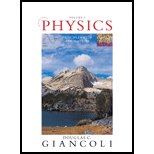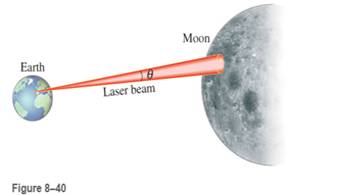
Physics
7th Edition
ISBN: 9780321625915
Author: Douglas C. Giancoli
Publisher: PEARSON
expand_more
expand_more
format_list_bulleted
Textbook Question
Chapter 8, Problem 3P
A laser beam is directed at the Moon, 380,000 km from Earth. The beam diverges at an angle? (Fig. 8-40) of

Expert Solution & Answer
Trending nowThis is a popular solution!
Learn your wayIncludes step-by-step video

schedule03:59
Students have asked these similar questions
Make sure to draw a Free Body Diagram as well
Make sure to draw a Free Body Diagram as well
Make sure to draw a Free Body Diagram please as well
Chapter 8 Solutions
Physics
Ch. 8 - A solid ball and a solid cylinder roll down a...Ch. 8 - A bicycle odometer (which counts revolutions and...Ch. 8 - Prob. 2QCh. 8 - Prob. 3QCh. 8 - Why is it more difficult to do a sit-up with your...Ch. 8 - If the net force on a system is zero, is the net...Ch. 8 - Mammals that depend on being able to run fast have...Ch. 8 - This book has three symmetry axes through its...Ch. 8 - Can the mass of a rigid object be considered...Ch. 8 - The moment of inertia of a rotating solid disk...
Ch. 8 - Two inclines have the same height but make...Ch. 8 - Two spheres look identical and have the same mass....Ch. 8 - A sphere and a cylinder have the same radius and...Ch. 8 - Prob. 13QCh. 8 - Prob. 14QCh. 8 - 15. Can the diver of Fig. 8-28 do a somersault...Ch. 8 - When a motorcyclist leaves the ground on a jump...Ch. 8 - Prob. 17QCh. 8 - 18. The angular velocity of a wheel rotating on a...Ch. 8 - 19. In what direction is the Earth's angular...Ch. 8 - 20. ‘On the basis of the law of conservation of...Ch. 8 - Bonnie sits on the outer rim of a merry-go-round,...Ch. 8 - Prob. 2MCQCh. 8 - Prob. 3MCQCh. 8 - Prob. 4MCQCh. 8 - Prob. 5MCQCh. 8 - Prob. 6MCQCh. 8 - Prob. 7MCQCh. 8 - Prob. 8MCQCh. 8 - Prob. 9MCQCh. 8 - Prob. 10MCQCh. 8 - Prob. 11MCQCh. 8 - Prob. 12MCQCh. 8 - Suppose you are sitting on a rotating stool...Ch. 8 - Express the following angles in radians: (a)...Ch. 8 - The Sun subtends an angle of about 0.5° to us on...Ch. 8 - A laser beam is directed at the Moon, 380,000 km...Ch. 8 - The blades in a blender rotate at a rate of 6500...Ch. 8 - 5. (II) The platter of the hard drive of a...Ch. 8 - Prob. 6PCh. 8 - (a) A grinding wheel 0.35 m in diameter rotates at...Ch. 8 - Prob. 8PCh. 8 - Calculate the angular velocity (a) of a clock's...Ch. 8 - Prob. 10PCh. 8 - What is the linear speed, due to the Earth's...Ch. 8 - Prob. 12PCh. 8 - How fast (in rpm) must a centrifuge rotate ifa...Ch. 8 - Prob. 14PCh. 8 - Prob. 15PCh. 8 - Prob. 16PCh. 8 - An automobile engine slows down from 3500 rpm to...Ch. 8 - 18. (I) A centrifuge accelerates uniformly from...Ch. 8 - Prob. 19PCh. 8 - Prob. 20PCh. 8 - A wheel 31 cm in diameter accelerates uniformly...Ch. 8 - Prob. 22PCh. 8 - Prob. 23PCh. 8 - A 52-kg person riding a bike puts all her weight...Ch. 8 - Calculate the net torque about the axle of the...Ch. 8 - A person exerts a horizontal force of 42 N on the...Ch. 8 - Prob. 27PCh. 8 - The bolts on the cylinder head of an engine...Ch. 8 - Determine the net torque on the 2.0-m-long uniform...Ch. 8 - Determine the moment of inertia of a 10.8-kg...Ch. 8 - 31. (I) Estimate the moment of inertia of a...Ch. 8 - A merry-go-round accelerates from rest to 0.68...Ch. 8 - Prob. 33PCh. 8 - (II) A grinding wheel is a uniform cylinder with a...Ch. 8 - Prob. 35PCh. 8 - Prob. 36PCh. 8 - Prob. 37PCh. 8 - Prob. 38PCh. 8 - Prob. 39PCh. 8 - Prob. 40PCh. 8 - Prob. 41PCh. 8 - Prob. 42PCh. 8 - Prob. 43PCh. 8 - A centrifuge rotor rotating at 9200 rpm is shut...Ch. 8 - 45. (II) To get a flat, uniform cylindrical...Ch. 8 - 46. (Ill) Two blocks are connected by a light...Ch. 8 - 47 (III) An Atwood machine consists of two masses,...Ch. 8 - A hammer thrower accelerates the hammer (mass...Ch. 8 - 49. (I) An automobile engine develops a torque of...Ch. 8 - A centrifuge rotor has a moment of inertia of 325...Ch. 8 - Prob. 51PCh. 8 - Prob. 52PCh. 8 - Prob. 53PCh. 8 - Prob. 54PCh. 8 - Prob. 55PCh. 8 - Prob. 56PCh. 8 - Prob. 57PCh. 8 - Prob. 58PCh. 8 - Prob. 59PCh. 8 - What is the angular momentum of a 0.270-kg ball...Ch. 8 - (a) What is the angular momentum of a 2.8-kg...Ch. 8 - Prob. 62PCh. 8 - Prob. 63PCh. 8 - Prob. 64PCh. 8 - Prob. 65PCh. 8 - Prob. 66PCh. 8 - A person of mass 75 kg stands at the center of a...Ch. 8 - Prob. 68PCh. 8 - Prob. 69PCh. 8 - Prob. 70PCh. 8 - Prob. 71PCh. 8 - Prob. 72PCh. 8 - Prob. 73PCh. 8 - Prob. 74PCh. 8 - Prob. 75GPCh. 8 - Prob. 76GPCh. 8 - Prob. 77GPCh. 8 - Prob. 78GPCh. 8 - Prob. 79GPCh. 8 - Prob. 80GPCh. 8 - Prob. 81GPCh. 8 - Figure 8-59 illustrates an H20 molecule The O — H...Ch. 8 - A hollow cylinder (hoop) is rolling on a...Ch. 8 - Prob. 84GPCh. 8 - Prob. 85GPCh. 8 - Prob. 86GPCh. 8 - Prob. 87GPCh. 8 - Prob. 88GPCh. 8 - Prob. 89GPCh. 8 - Prob. 90GPCh. 8 - A large spool of rope rolls on the ground with the...Ch. 8 - The Moon orbits the Earth such that the same side...Ch. 8 - Prob. 93GPCh. 8 - Most of our Solar System's mass is contained in...Ch. 8 - Prob. 95GPCh. 8 - Prob. 96GP
Additional Science Textbook Solutions
Find more solutions based on key concepts
a. Draw the mechanism for the following reaction if it a involves specific-base catalysis. b. Draw the mechanis...
Organic Chemistry (8th Edition)
55. You’re 6.0 m from one wall of the house seen in FIGURE P4.55. You want to toss a ball to your friend who i...
Physics for Scientists and Engineers: A Strategic Approach, Vol. 1 (Chs 1-21) (4th Edition)
3. What are serous membranes, and what are their functions?
Human Anatomy & Physiology (2nd Edition)
A mixed culture of Escherichia coli and Penicillium chrysogenum is inoculated onto the following culture media....
Microbiology: An Introduction
All of the following terms can appropriately describe humans except: a. primary consumer b. autotroph c. hetero...
Human Biology: Concepts and Current Issues (8th Edition)
18. SCIENTIFIC THINKING By measuring the fossil remains of Homo floresiensis, scientists have estimated its wei...
Campbell Biology: Concepts & Connections (9th Edition)
Knowledge Booster
Learn more about
Need a deep-dive on the concept behind this application? Look no further. Learn more about this topic, physics and related others by exploring similar questions and additional content below.Similar questions
- please answer this asap!!!!arrow_forwardRT = 4.7E-30 18V IT = 2.3E-3A+ 12 38Ω ли 56Ω ли r5 27Ω ли r3 28Ω r4 > 75Ω r6 600 0.343V 75.8A Now figure out how much current in going through the r4 resistor. |4 = unit And then use that current to find the voltage drop across the r resistor. V4 = unitarrow_forward7 Find the volume inside the cone z² = x²+y², above the (x, y) plane, and between the spheres x²+y²+z² = 1 and x² + y²+z² = 4. Hint: use spherical polar coordinates.arrow_forward
- ганм Two long, straight wires are oriented perpendicular to the page, as shown in the figure(Figure 1). The current in one wire is I₁ = 3.0 A, pointing into the page, and the current in the other wire is 12 4.0 A, pointing out of the page. = Find the magnitude and direction of the net magnetic field at point P. Express your answer using two significant figures. VO ΜΕ ΑΣΦ ? Figure P 5.0 cm 5.0 cm ₁ = 3.0 A 12 = 4.0 A B: μΤ You have already submitted this answer. Enter a new answer. No credit lost. Try again. Submit Previous Answers Request Answer 1 of 1 Part B X Express your answer using two significant figures. ΜΕ ΑΣΦ 0 = 0 ? below the dashed line to the right P You have already submitted this answer. Enter a new answer. No credit lost. Try again.arrow_forwardAn infinitely long conducting cylindrical rod with a positive charge λ per unit length is surrounded by a conducting cylindrical shell (which is also infinitely long) with a charge per unit length of −2λ and radius r1, as shown in the figure. What is σinner, the surface charge density (charge per unit area) on the inner surface of the conducting shell? What is σouter, the surface charge density on the outside of the conducting shell? (Recall from the problem statement that the conducting shell has a total charge per unit length given by −2λ.)arrow_forwardA small conducting spherical shell with inner radius aa and outer radius b is concentric with a larger conducting spherical shell with inner radius c and outer radius d (Figure 1). The inner shell has total charge +2q, and the outer shell has charge −2q. What's the total charge on the inner surface of the small shell? What's the total charge on the outer surface of the small shell? What's the total charge on the inner surface of the large shell? What's the total charge on the outer surface of the large shell?arrow_forward
arrow_back_ios
SEE MORE QUESTIONS
arrow_forward_ios
Recommended textbooks for you
 Physics for Scientists and EngineersPhysicsISBN:9781337553278Author:Raymond A. Serway, John W. JewettPublisher:Cengage Learning
Physics for Scientists and EngineersPhysicsISBN:9781337553278Author:Raymond A. Serway, John W. JewettPublisher:Cengage Learning Physics for Scientists and Engineers with Modern ...PhysicsISBN:9781337553292Author:Raymond A. Serway, John W. JewettPublisher:Cengage Learning
Physics for Scientists and Engineers with Modern ...PhysicsISBN:9781337553292Author:Raymond A. Serway, John W. JewettPublisher:Cengage Learning Principles of Physics: A Calculus-Based TextPhysicsISBN:9781133104261Author:Raymond A. Serway, John W. JewettPublisher:Cengage Learning
Principles of Physics: A Calculus-Based TextPhysicsISBN:9781133104261Author:Raymond A. Serway, John W. JewettPublisher:Cengage Learning Classical Dynamics of Particles and SystemsPhysicsISBN:9780534408961Author:Stephen T. Thornton, Jerry B. MarionPublisher:Cengage Learning
Classical Dynamics of Particles and SystemsPhysicsISBN:9780534408961Author:Stephen T. Thornton, Jerry B. MarionPublisher:Cengage Learning Glencoe Physics: Principles and Problems, Student...PhysicsISBN:9780078807213Author:Paul W. ZitzewitzPublisher:Glencoe/McGraw-Hill
Glencoe Physics: Principles and Problems, Student...PhysicsISBN:9780078807213Author:Paul W. ZitzewitzPublisher:Glencoe/McGraw-Hill University Physics Volume 1PhysicsISBN:9781938168277Author:William Moebs, Samuel J. Ling, Jeff SannyPublisher:OpenStax - Rice University
University Physics Volume 1PhysicsISBN:9781938168277Author:William Moebs, Samuel J. Ling, Jeff SannyPublisher:OpenStax - Rice University

Physics for Scientists and Engineers
Physics
ISBN:9781337553278
Author:Raymond A. Serway, John W. Jewett
Publisher:Cengage Learning

Physics for Scientists and Engineers with Modern ...
Physics
ISBN:9781337553292
Author:Raymond A. Serway, John W. Jewett
Publisher:Cengage Learning

Principles of Physics: A Calculus-Based Text
Physics
ISBN:9781133104261
Author:Raymond A. Serway, John W. Jewett
Publisher:Cengage Learning

Classical Dynamics of Particles and Systems
Physics
ISBN:9780534408961
Author:Stephen T. Thornton, Jerry B. Marion
Publisher:Cengage Learning

Glencoe Physics: Principles and Problems, Student...
Physics
ISBN:9780078807213
Author:Paul W. Zitzewitz
Publisher:Glencoe/McGraw-Hill

University Physics Volume 1
Physics
ISBN:9781938168277
Author:William Moebs, Samuel J. Ling, Jeff Sanny
Publisher:OpenStax - Rice University
GCSE Physics - Vector Diagrams and Resultant Forces #43; Author: Cognito;https://www.youtube.com/watch?v=U8z8WFhOQ_Y;License: Standard YouTube License, CC-BY
TeachNext | CBSE Grade 10 | Maths | Heights and Distances; Author: Next Education India;https://www.youtube.com/watch?v=b_qm-1jHUO4;License: Standard Youtube License